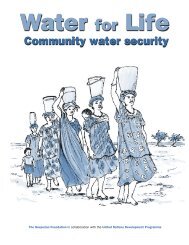A Sourcebook - UN-Water
A Sourcebook - UN-Water
A Sourcebook - UN-Water
Create successful ePaper yourself
Turn your PDF publications into a flip-book with our unique Google optimized e-Paper software.
1 INTRODUCTION<br />
The city is parched. In the slums and squatter settlements, women schedule their lives around<br />
the two hours a day that water trickles from the low taps near their one-room dwellings. Others<br />
less fortunate buy water from men with tanks on handcarts. The men fill their tanks at a broken<br />
main a mile away. No matter where the water comes from, all is contaminated by the sewage<br />
that percolates through the ground into the broken water pipes. The septic tanks of the middle<br />
classes contaminate the groundwater, while in the squatter settlements on the edge of town,<br />
a private place to defecate is almost impossible to find. Flies swarm the exposed faeces, then<br />
land on food in the makeshift kitchens of the shacks nearby.<br />
In the better parts of town, residents have constructed elaborate systems of underground tanks<br />
to store water, overhead tanks for pressure, suction pumps to draw the scarce water from the<br />
utility’s pipes, boreholes, tankers, and second, illegal connections in the struggle to get enough<br />
water. Five star hotels have water trucked in. The tanker drivers charge a hefty price for their<br />
valuable product, yet fill their tankers from the utility’s systems for free. The Government has<br />
borrowed hundreds of millions of dollars from the World Bank and others over the years, which<br />
it lent to the utility to build massive treatment works and transmission lines to bring water to the<br />
thirsty city. The utility never serviced any of these loans, so now they burden the taxpayers of<br />
the country. Still the city thirsts.<br />
Why? Could it be because the utility staff, paid a pittance and ill equipped for their formal job,<br />
supplement their income by providing water for free through illegal connections, fix meters,<br />
and omit billing data? Is it because the city councilors take a 10 percent cut of all the construction<br />
contracts awarded, and the contractors make their money back by using shoddy<br />
materials and workmanship that leaks and decays quickly? Perhaps the men who own the<br />
tanker fleets finance the campaigns of leading politicians, who quietly sabotage attempts to<br />
make the utility work properly, since this would take away the tanker drivers’ business?<br />
<strong>Water</strong> and sanitation providers fail to serve citizens for many reasons. The ultimate cause is poor governance<br />
at the utility, sector, and government levels. Corruption is among the serious symptoms of poor<br />
governance—corrosive in its effects, causing more harm in waste and bad decisions than even the<br />
money that changes hands as bribes and kickbacks would suggest. This <strong>Sourcebook</strong> aims to help sector<br />
practitioners to:<br />
• Assess the extent and risk of corruption in sectors in which they work<br />
• Improve governance in ways that will reduce corruption.<br />
1.1 What’s in the <strong>Sourcebook</strong><br />
This <strong>Sourcebook</strong> is in four parts:<br />
• Section 2 is about understanding corruption. What is it, what sustains it, how does it relate to<br />
governance, and how might it be reduced?<br />
• Part I is about assessing the risks, extent, and locales of corruption in a particular country<br />
• Part II turns to ways to reduce corruption by improving governance<br />
Part III is about<br />
• monitoring and evaluating measures implemented to improve governance, to<br />
allow learning from experience.<br />
1
















